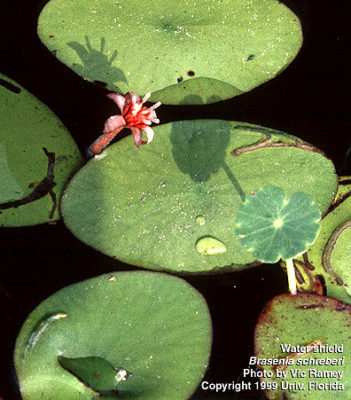 Develops from slender black and fibrous roots anchored into the substrate. A mucous or jelly-like substance coats all parts of the submersed portions of the plant. The stems and underside of the elliptical leaves are purple, while the upper portions of the leaves are green. The leaves can grow up to 5 inches long and 3 inches wide.
Develops from slender black and fibrous roots anchored into the substrate. A mucous or jelly-like substance coats all parts of the submersed portions of the plant. The stems and underside of the elliptical leaves are purple, while the upper portions of the leaves are green. The leaves can grow up to 5 inches long and 3 inches wide.
Treatment options for watershield
| Control Method | Dosage | Comments | Cost | Unit Cost |
|---|---|---|---|---|
| 2,4-D | 100-200 lbs/acre | Note water use restrictions | $122/50 lb bag | $244-$488/acre |
| Fluridone (Sonar) | 0.5-1.5 quarts/acre | Irrigation only water use restriction | $465/quart | $700/acre |
| Glyphosate (Rodeo) | 3 oz/gal spray/acre | Add Surfactant Do not apply w/in 1/2 mile Potable Water Intake | $59.95 gallon | $2.81 – $59.95/acre |
Description of Treatment Options
- Chemically treating a pond with herbicides approved for aquatic use can be effective for many types of vegetation. Chemical treatments can be very effective in controlling vegetation especially in small areas of a pond such as swimming areas or boat ramps. Herbicides generally provide quick results, but plants often return and several applications may be necessary to maintain control. When using herbicides/pesticides, protect yourself and others by strictly following all label directions. Certain herbicides can be purchased and used only by Certified Pesticide Applicators, so herbicide treatment may not be possible without paying someone to do it for you. Additionally, community or shared waters (several landowners) requires herbicide application to be done by individuals with a Certified Pesticide Applicators License. Individuals that treat their own ponds should keep the rule of thirds in mind when applying herbicides. Treat 1/3 of the pond, then wait at least ten days prior to treating the next 1/3 and then treat the last 1/3 after another ten days elapses. By treating 1/3 of the pond at a time, fish kills attributed to low dissolved oxygen as a result of decaying plant matter can be prevented. Treatments should not be conducted during very hot or dry weather conditions since these conditions often produce low oxygen levels and plant treatments will only further deplete oxygen levels.

